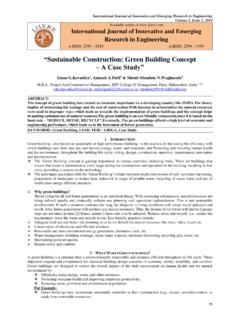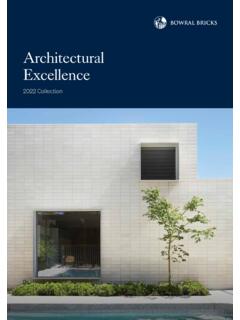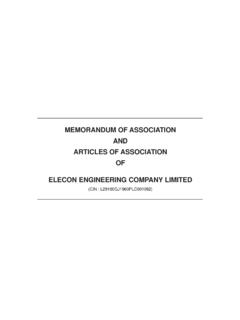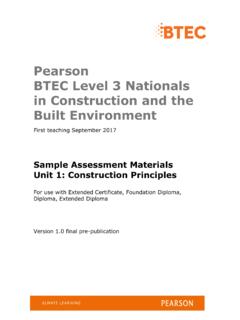Transcription of DETAILED FEASIBILITY REPORT ON CONSTRUCTION MATERIALS
1 DETAILED FEASIBILITY REPORT ON. CONSTRUCTION MATERIALS . Part 1. For DEPARTMENT OF INDUSTRIES. MINISTRY OF ECONOMIC AFFAIRS. ROYAL GOVERNMENT OF BHUTAN. By IDRG CONSULTANCY SERVICES. In Association with Sherpa Consultancy February, 2009. 1. CONTENTS. Executive Summary .. 3-12. 1. Chapter I Introduction . 13-17. 2. Chapter II Consultation & Review of the Literature & Information 18-24. 3. Chapter III Economic Sectors with Demand Potential for CONSTRUCTION MATERIALS ..25-31. 4. Chapter IV CONSTRUCTION MATERIALS Type & Requirement .32-39. 5. Chapter V Selection of Viable Projects-Issues and Approach .. 40-46. Annexures . 47-57. Annexure I - List of persons contacted Annexure II - List of references Annexure III - Project Profiles - 1. Wire Nails - 2. Lime stone based products Burnt Line - 3.
2 Plaster of Paris 2. Executive Summary 3. Register to Remove Trial Watermark!! EXECUTIVE SUMMARY. Part I - Review of the CONSTRUCTION MATERIALS scenario and identification of potential projects 1. Bhutan is passing through fast growing phase of development. Starting in early 1960, Bhutan embarked on planned economic development through successive five-year plans. Over the years, ever-increasing generation of electricity by installation of new hydropower projects has facilitated the establishment of new industries within the broad framework of sustainable and environmental friendly development. As power, transport and other infrastructure are the basic requirements for economic growth, the development of infrastructure has also been in the focus of developmental programmes.
3 Over the years a number of power projects, roads, bridges, hospitals, schools and commercial and residential buildings have been built. This has resulted in a rapidly growing CONSTRUCTION industry. 2. The main sectors of the emphasis in the development of infrastructure have been hydro-electric power, roads and bridges, urban infrastructure & buildings and this has given a boost to the CONSTRUCTION industry resulting in higher demands of CONSTRUCTION MATERIALS . The establishment of new power projects will involve a large number of CONSTRUCTION activities including buildings at the project site and consequently huge quantity of building CONSTRUCTION MATERIALS would be required. Further, with the planned hydropower projects for the 10th plan, many of which lie in the interior parts of the country, the present width and capacity of highways, roads and bridges could prove a bottleneck for effective transportation of large hydro plants and equipments and CONSTRUCTION MATERIALS to the sites of these hydropower projects.
4 The facilitation of accelerated development of hydropower will therefore require new roads to the constructed and existing highways and roads to be resurfaced, realigned and widened. 3. A large hydroelectric power project with capacity of 1100 MW in the first phase and 1000 MW in the second phase in being setup at Lobeysa in Wangdue. The work on the project has already started. There is a provision for constructing a residential colony with around 700 residential units for the project personnel. A. general hospital, building for office complex and a club building is also planned to be constructed. Besides there would be lot of CONSTRUCTION activities in private sector due to setting up of the hydroelectric power project. Besides cement and steel there would be a large demand for stone aggregates, stone dust and cement products.
5 4. With the acceleration in the process of urbanization, and consequently, the rapid growth in urban population, the urban infrastructure and public amenities need to be strengthened to address the emerging urban requirement. There are urban plans for setting up 31 towns of which implementation plans of 17 are in various 4. Register eDocPrinter PDF Pro Online Now!! Register to Remove Trial Watermark!! stages of finalization. Similarly, there are ambitious targets for strengthening road and bridges sector. This scenario will result in providing a boost to CONSTRUCTION industry. 5. It is estimated that the CONSTRUCTION sector accounts for nearly 25 per cent contribution to Bhutan GDP. The fact remains that in a developing economy like Bhutan, the CONSTRUCTION becomes the major activity in various spheres of developments be it power, road, urban infrastructure and housing, education health, communication, etc.
6 The CONSTRUCTION industry covers a wide range of sectors of economy, the most important in the context of Bhutan being hydroelectric power generation and distribution, roads and bridges, urban infrastructure development, housing, government and private building complexes, expansion of health and education facilities viz. CONSTRUCTION of hospitals and schools. With such a base of the CONSTRUCTION industry sector, it is desirable to have assessment of the current and future scenario of development of the CONSTRUCTION intensive sector of the economy in order to visualize the emerging scenario of CONSTRUCTION industry in Bhutan and resultant demand of CONSTRUCTION MATERIALS . 6. With a view to cut down the cost of raw MATERIALS in CONSTRUCTION industries and also to accelerate the pace of industrialization in Bhutan, the government is keen to promote industrial units for manufacture of CONSTRUCTION MATERIALS .
7 Setting up of such industries would help in easy availability of CONSTRUCTION MATERIALS at economic prices, generation of employment opportunities, optimum use of natural and human resources and above all accelerating the pace of industrialization in the country. 7. In view of the above, it has been decided to undertake DETAILED FEASIBILITY studies of the CONSTRUCTION MATERIALS with a view to identify the viable projects in this field and to develop DETAILED information on the identified project. The concept is that such DETAILED information would be made available to entrepreneurs to help them in taking investment decision. Accordingly, the project on DETAILED FEASIBILITY studies in the field of CONSTRUCTION MATERIALS has been assigned to IDRG. consultancy services.
8 The objective of the project is to identify viable projects in the field of CONSTRUCTION MATERIALS and carry out DETAILED FEASIBILITY analysis of the identified project. 8. The requirement and type of CONSTRUCTION MATERIALS depends on the type of CONSTRUCTION project in power projects, cement, steel and stone aggregates constitute the major requirement, in road CONSTRUCTION project, bitumen and stone aggregates happen to be major requirements, while the CONSTRUCTION of buildings require a wide range of other MATERIALS besides cement, steel, stone aggregates and bricks. The CONSTRUCTION MATERIALS encompass a wide range of MATERIALS and products, viz. steel in different forms, cement and cement products, wooden items, metal hard wares and other products, plastic pipes and other chemical products.
9 In the context of this study, it appears to be more logical to classify the 5. Register eDocPrinter PDF Pro Online Now!! Register to Remove Trial Watermark!! building MATERIALS based on their raw material of manufacture or their utilization in the CONSTRUCTION industry. 9. Keeping in view, the estimates of the demand level for various items of CONSTRUCTION MATERIALS , analysis of market scenario, 14 different products were identified having potential for production in Bhutan. Further, based on various parameters viz estimated current demand level, potential for growth in demand, existing manufacturing facilities in Bhutan, availability of raw MATERIALS , technology and machines, possibilities of adaptation of manufacturing technology, advantages of other factor inputs, two viable projects for DETAILED FEASIBILITY studies were selected.
10 These included cement based products and roto moulded plastic containers and other products. These FEASIBILITY studies are given in part II and III of the REPORT . 10. Though there is a boom in the CONSTRUCTION industry in Bhutan, keeping in view the size of population, the demand for individual items would not be sufficient for setting up an economically viable unit. In the circumstances, the best option would be to study the FEASIBILITY for a group of products involving similar technology in order to set up viable indigenous production units. Based on this consideration, the FEASIBILITY studies for various cement based products and a range of roto moulded plastic products has been included in the study. 11. A cluster approach for developing similar product based units has also been recommended for accelerating the pace of industrialization in Bhutan.








